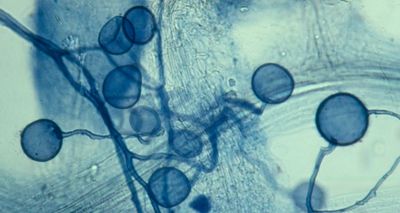Glomeromycota
The Glomeromycota are not as diverse as other phyla of fungi nor are there as many species. However they make up for this uniformity by being among the most abundant and widespread of all fungi. As far as we know, all species of Glomeromycota are mutualistic with plants, forming arbuscular mycorrhizal. (Arbuscular Mycorrhizal Fungi).

These fungi were considered to be members of the Zygomycota for many years, mainly because their hyphae lack septa and because their spores may superficially resemble zygospores. More recent genetic evidence shows that they are quite distinct from other fungi and definitely belong in a separate phylum. Palaeontologists have suspected this for a long time. The fossil roots of plants known to be as old as 450 million years clearly contain the hyphae and spores of Glomeromycota, showing this group to be among the oldest of fungi. The left photograph shows hyphae and spores of a species of Glomus, collected from the soil surrounding the roots of a balsam poplar tree. Such structures are indistinguishable from some fossil collections.

Reproduction
The Glomeromycota reproduction by produce the spores. There is no evidence that the Glomeromycota reproduce sexually. Studies using molecular marker genes have detected little or no genetic recombination so it is assumed generally that the spores are formed asexually.
No member of the Glomeromycota has ever been grown in the laboratory independently of its plant associate.It is still not known exactly what these fungi need as nutrients.
Symbiotic Relationship
The Glomeromycota have the symbiotic relationship with plants, and they have many evidence shows, the glomeromycota must survive depend on carbon and energy which plants produced.
Colonization
New colonization of AM fungi largely depends on the amount of inoculum present in the soil. Although pre-existing hyphae and infected root fragments have been shown to successfully colonize the roots of a host, germinating spores are considered to be the key players in new host establishment. Spores are commonly dispersed by fungal and plant burrowing herbivore partners, but some air dispersal capabilities are also known. Studies have shown that spore germination is specific to particular environmental conditions such as right amount of nutrients, temperature or host availability. It has also been observed that the rate of root system colonization is directly correlated to spore density in the soil.In addition, new data also suggests that AM fungi host plants also secrete chemical factors which attract and enhance the growth of developing spore hyphae towards the root system.